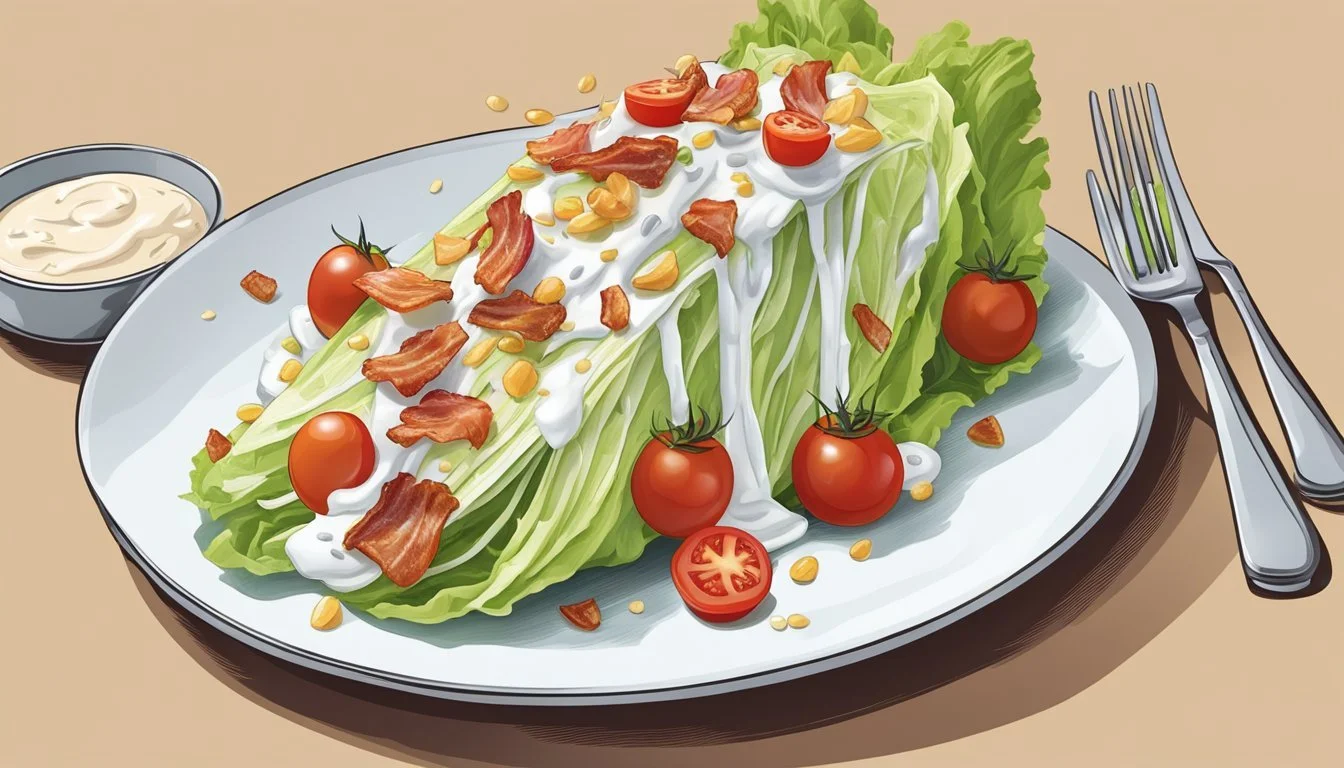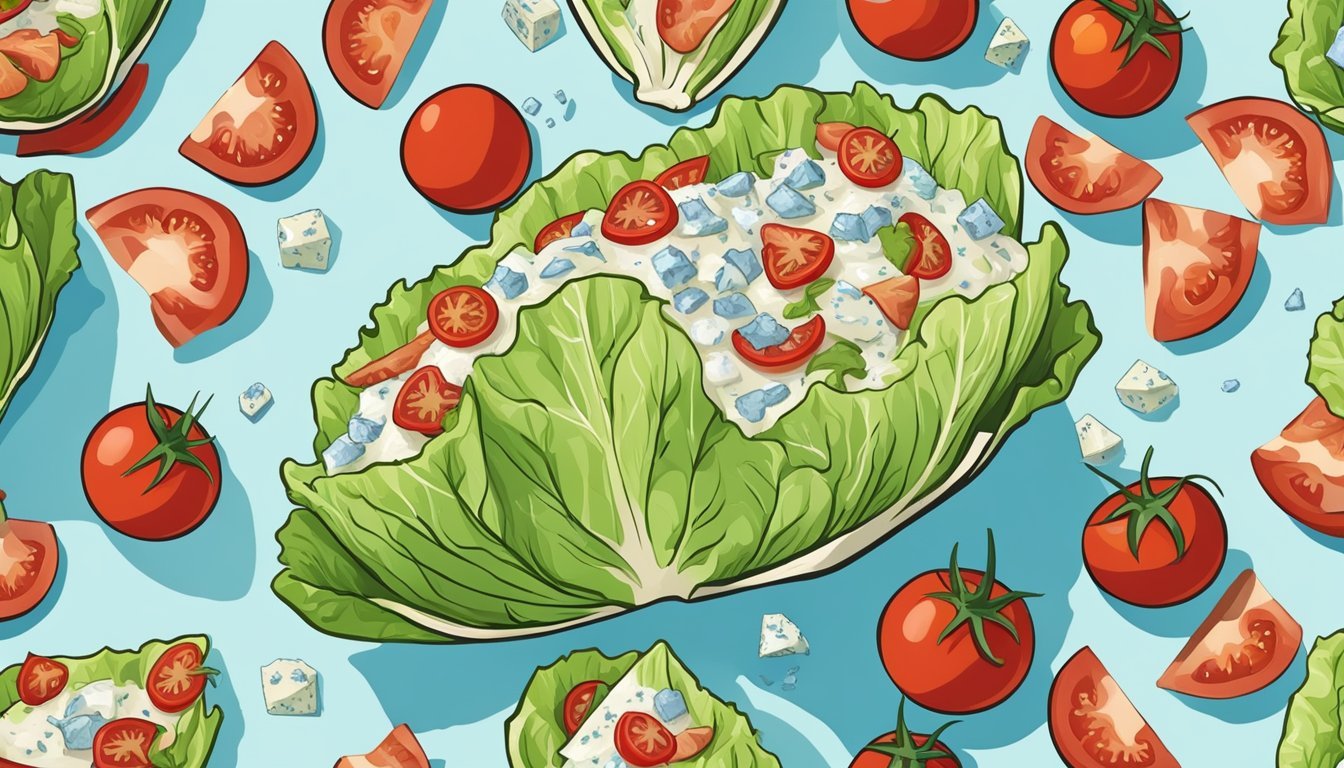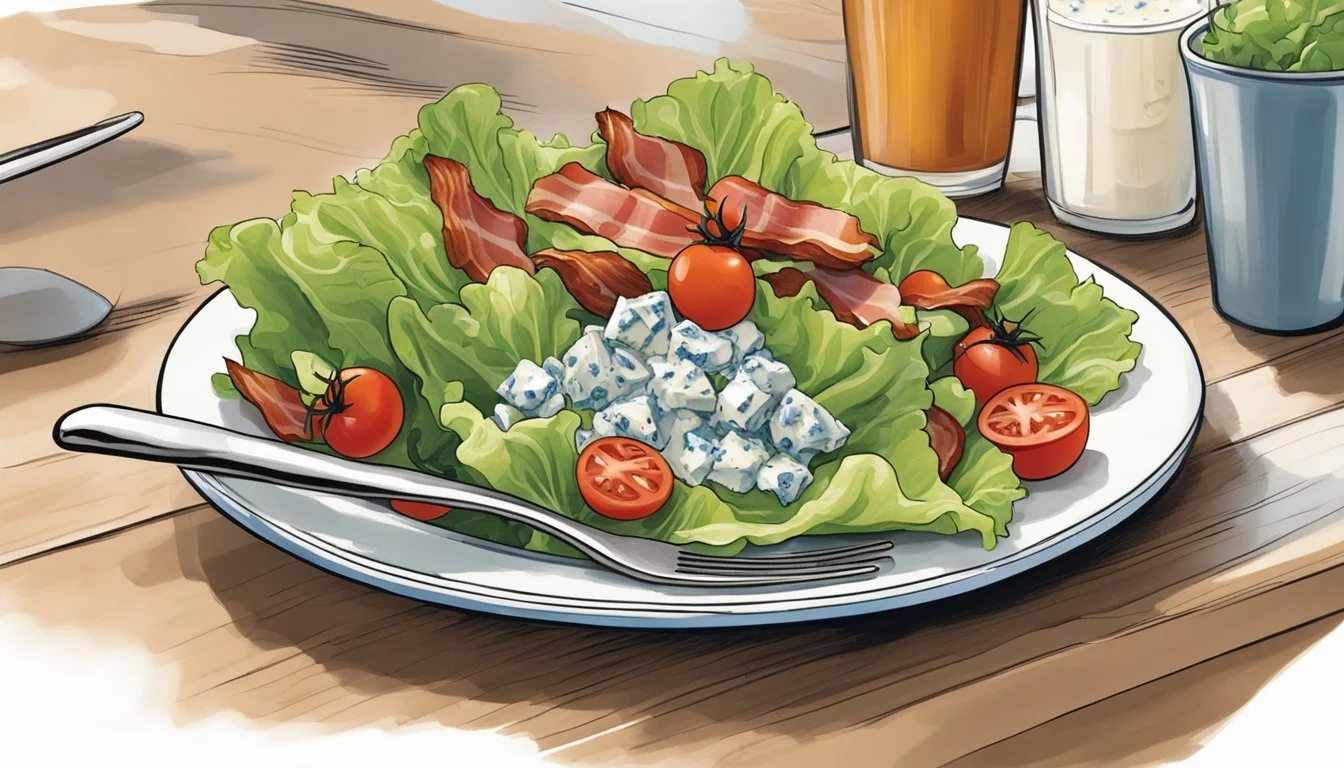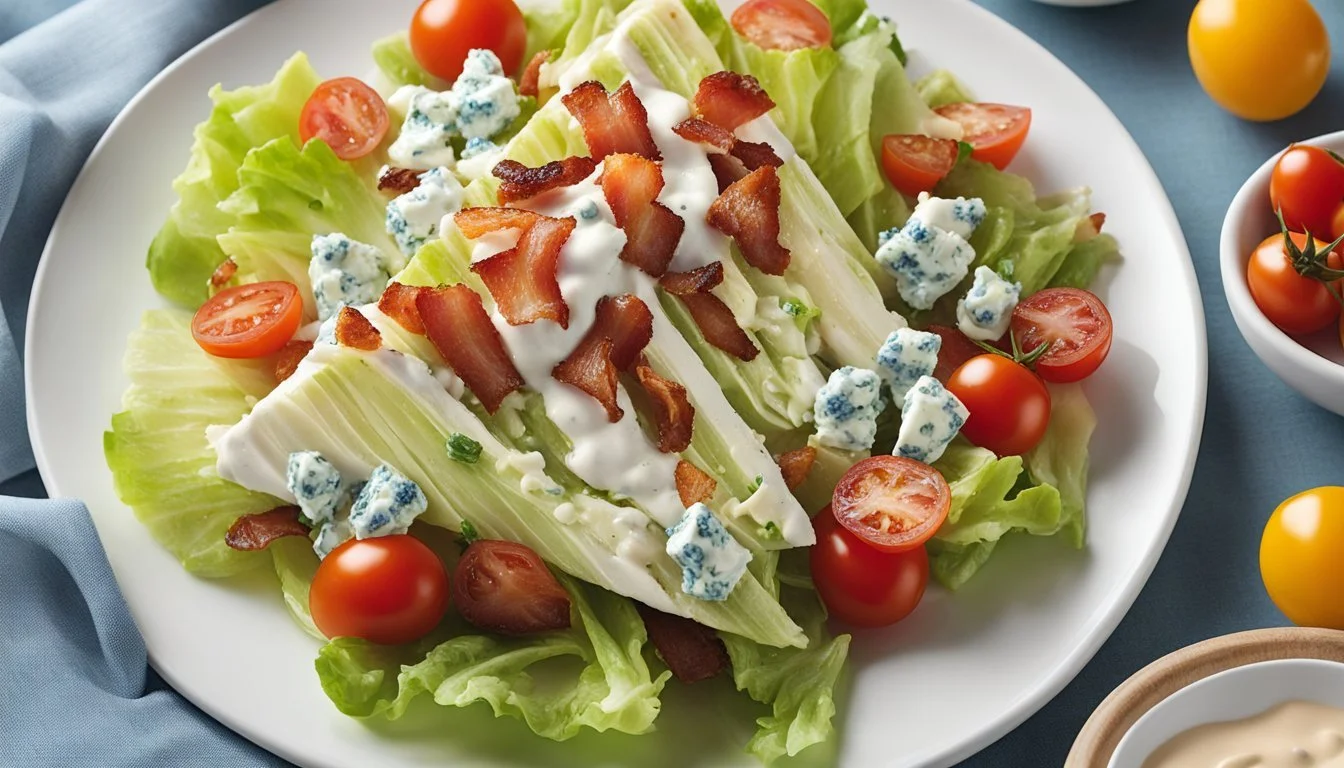How to Eat a Wedge Salad
A Step-by-Step Guide
Eating a wedge salad is a simple affair that involves a bit of technique to enjoy the dish properly. The wedge salad, typically a quarter head of iceberg lettuce, is known for its crispness and is often served with various toppings like bacon (how long does bacon last?), bleu cheese, and creamy dressings. Diners might find this dish served as a cool, refreshing starter in restaurants or at a formal dinner. It presents a blend of textures and flavors that require a certain level of finesse to eat.
The approach to consuming a wedge salad involves using a knife and fork. The diner places the fork into the lettuce wedge to hold it steady on the plate. With the fork securing the salad, a knife is then used to slice off manageable, bite-sized portions starting from the tip of the wedge closest to the eater. This method ensures that each piece has a balanced mix of lettuce, dressing, and toppings.
The critical aspect of indulging in a wedge salad is to ensure that every bite includes a piece of the crisp lettuce and a sampling of the toppings. Preparation is simple, slicing a head of iceberg lettuce into quarters or sixths depending on size, then garnishing with a homemade or pre-made dressing, and toppings like crispy bacon bits, cherry tomatoes, or crumbled blue cheese. The goal is to maintain the integrity of the salad while ensuring ease of eating and enjoyment of the dish's varied flavors and textures.
What Is a Wedge Salad?
A wedge salad is a traditional American salad that features a quarter of iceberg lettuce as its base, typically adorned with a rich blue cheese dressing and a variety of toppings such as bacon, tomatoes, and chives (how long do chives last?).
History of the Classic Wedge Salad
The classic wedge salad dates back to the early 20th century as a creation of convenience using the crisp and sturdy iceberg lettuce. It gained popularity for its simplicity and its blend of textures and flavors.
Key Ingredients of a Wedge Salad
The main components of a wedge salad include:
Iceberg lettuce: The center of the salad, cut into a wedge shape, providing a crunchy texture.
Blue cheese dressing: Drizzled over the wedge, adding a creamy and tangy flavor profile.
Blue cheese crumbles: Often sprinkled atop for an extra burst of flavor.
Bacon: Cooked to a crisp and crumbled for a salty and smoky addition.
Tomatoes: Typically fresh and diced to add a juicy, sweet contrast.
Chives: Chopped and sprinkled over the salad for a mild onion-like essence.
Nutritional Overview
A wedge salad's nutritional content can vary based on the ingredients and dressing used. This section breaks down the typical nutritional elements found in a standard wedge salad.
Caloric Content
A traditional wedge salad consists of a quarter head of iceberg lettuce with toppings such as bacon, blue cheese dressing, tomatoes, and red onions. The caloric content predominantly hinges on the dressing and toppings. A standard serving may contain approximately 300-500 calories.
Macronutrient Breakdown
The macronutrients in a wedge salad include protein, fats (including saturated fat), and carbohydrates, which encompass sugars and fiber.
Protein: Contributed mainly by bacon and cheese, a serving may provide about 10-15 grams of protein.
Fats: The majority of fats come from the salad dressing and bacon. Total fat content can range from 20-30 grams, with saturated fat varying depending on the dressing's creaminess.
Carbohydrates: Mostly from vegetables, a single serving might contain 10-15 grams, with a portion of that as dietary fiber and natural sugars.
Vitamins and Minerals
Wedge salads (What wine goes well with salads?) provide essential vitamins and minerals, varying with the choice of vegetables and toppings.
Calcium and Potassium: Present due to cheese and leafy greens.
Vitamin C and Vitamin A: Tomatoes and lettuce contribute to the vitamin content.
Iron: Found in both the leafy greens and the bacon.
Sodium: This can be high due to cured bacon and cheese, reaching upwards of 700-1000 mg per serving.
Preparing the Wedge Salad
When preparing a wedge salad, selecting the right type of lettuce and cutting it properly are essential steps to create this classic and refreshing dish.
Selecting the Lettuce
The ideal choice for a wedge salad is iceberg lettuce, known for its crispness and firm structure. One should search for a head of iceberg that feels heavy for its size, indicating freshness and a high water content. The outer leaves are often removed as they can be wilted or dirty.
Cutting the Wedge
To create the iconic wedge shape, the head of iceberg lettuce should be quartered. It's important to first remove any residual dirt by rinsing the head under cold water. Once clean and pat-dried, place the lettuce on a cutting board with the stem side down. One should cut the lettuce into four equal sections, starting from the stem and slicing down to ensure that each wedge holds together.
Cutting Steps:
Slice the lettuce in half through the stem.
Cut each half into two equal wedges.
For serving, a wedge is placed on a plate with the cut side up, ready to be dressed and garnished.
Assembling the Salad
When constructing a wedge salad, precision in layering the toppings and evenly drizzling the dressing transforms simple ingredients into a harmonious dish.
Arranging Toppings
One begins by placing a crisp quarter of iceberg lettuce on the plate. This acts as a sturdy base for the toppings. The traditional ingredients include diced tomatoes or cherry tomatoes, crumbled blue cheese, and cooked bacon, which is often cut into small pieces for easy consumption. For a richer variant, avocado slices and red onion rings may be added. Here is a concise arrangement of toppings:
Tomatoes: Cherry tomatoes halved, or diced tomatoes scattered atop the wedge.
Bacon: Evenly distribute cooked, crispy bacon bits across.
Crumbled Blue Cheese: Generously sprinkle blue cheese over the lettuce.
Optional add-ons:
Avocado: Sliced or diced, placed around the wedge.
Red Onion: Thinly sliced rings nestled among the other toppings.
Croutons: Scattered for added crunch.
Drizzling Dressing
The dressing is a critical component, it should be applied with care to avoid overwhelming the greens. For a classic wedge salad, blue cheese dressing is the go-to choice. The method of application will ensure each bite contains a balanced flavor profile:
Blue Cheese Dressing: Drizzle the dressing evenly in a zigzag pattern over the wedge, ensuring it touches most of the toppings.
Ensure each layer receives some dressing, for it acts as a flavor enhancer for the toppings and lettuce alike.
Customizing Your Wedge Salad
The classic wedge salad is a versatile dish that allows for a variety of toppings and protein additions to suit any palate. By customizing the salad, diners can transform the simple wedge into a more substantial and personalized meal.
Alternate Toppings
A traditional wedge salad typically comes with blue cheese dressing, bacon, and tomatoes. However, one can easily enhance the flavors and textures by incorporating a mix of savory and fresh elements. For alternate toppings consider the following additions:
Cheese: Crumbled feta or shredded cheddar can be good alternatives to blue cheese.
Vegetables: Fresh diced cucumbers, red onions, or piquant radishes can add a refreshing crunch.
Nuts and Seeds: Toasted walnuts, pecans, or sunflower seeds can lend a nutty flavor and additional texture.
Dressings: Experiment with ranch, honey mustard, or a balsamic reduction for a different taste profile.
Protein Additions
Adding protein to a wedge salad makes it heartier and can serve as a satisfying meal on its own. Here are some proteins that complement the crisp iceberg lettuce well:
Poultry: Slices of grilled chicken or diced baked chicken breast provide a lean protein boost.
Seafood: Chilled, cooked shrimp or a filet of grilled salmon (What wine goes well with salmon?) can offer a luxurious twist to the salad.
Meat: Thinly sliced steak can elevate the wedge salad into a steakhouse-worthy dish.
Eggs: A hard-boiled egg, either sliced or crumbled, adds both protein and a classic salad topping.
Serving and Eating
When serving and eating a wedge salad, one should use the correct utensils and follow proper eating etiquette to ensure they enjoy this dish as intended. This section lays out the specifics of how to properly use utensils and the etiquette involved in consuming a wedge salad, lending itself as an excellent side dish that can be both elegant and refreshing.
Proper Utensils
Fork: Use a fork with the tines facing down to secure the wedge while cutting.
Knife: A knife is necessary to cut bite-sized pieces from the wedge.
It's crucial for diners to have both a sharp knife and a fork for the task of eating a wedge salad. The wedge shape can be challenging to navigate without the proper tools, as the diner needs to cut through the crisp lettuce and toppings effectively.
Eating Etiquette
Cutting: Diners should cut one bite-sized piece at a time from the tip of the wedge closest to them.
Secure the Wedge: While cutting, they should use their fork to hold the salad in place.
Salad eaters should approach the wedge with both utensils ready, cutting and consuming one piece at a time to maintain a sense of decorum. The expectation is for the individual to cut as they go, rather than dissect the salad into pieces all at once, allowing for a more manageable and enjoyable eating experience.
Homemade Dressing Variations
Creating the perfect homemade dressing can elevate a wedge salad from good to exceptional. A well-crafted dressing complements the crispness of the iceberg lettuce and enhances the overall flavor profile of the salad.
Blue Cheese Dressing
A classic Blue Cheese Dressing is a staple for wedge salads. It's typically made with a base of mayonnaise and sour cream, providing a rich and creamy texture. Buttermilk is often added to bring a tangy note that balances the robust flavor of the blue cheese. For a basic blue cheese dressing, one could combine the following:
1/2 cup mayonnaise
1/2 cup sour cream
1/3 cup buttermilk
4 oz blue cheese, crumbled
1 clove garlic, minced
Salt and freshly ground black pepper to taste
Mix all ingredients until smooth, and for those who prefer a chunkier texture, additional crumbled blue cheese can be folded in after blending.
Ranch and Other Variations
On the other hand, Ranch Dressing is favored for its herbal notes and versatile appeal. A homemade ranch can be easily whipped up with:
1/2 cup mayonnaise
1/2 cup sour cream
1/4 cup buttermilk
1 tablespoon fresh chives, chopped
1 tablespoon fresh dill, chopped
1 clove garlic, minced
Salt and freshly ground black pepper to taste
For an alternative twist, Avocado Ranch brings a fresh and slightly healthier option to the table. Simple substitutes or additions such as pureed avocado can provide a more nuanced flavor along with a boost in nutritional value.
When assembling either of these dressings, the chef should first combine the creamy base ingredients, then carefully blend in herbs and seasoning to ensure a well-balanced dressing that will enhance the wedge salad experience. Whether one leans towards the pungent delight of blue cheese or the herby freshness of ranch, both dressings can be adjusted to one's taste by tweaking the amount of garlic, seasoning, and the central flavors like blue cheese or herbs.
Health Considerations
Eating a wedge salad can be nutritious, but one must carefully consider its sodium and fat content. There are strategies to manage these while amplifying the salad's nutritional benefits.
Managing Sodium and Fat
Wedge salads often feature dressings high in sodium and saturated fat. To reduce sodium intake, one might opt for a dressing lower in salt or a homemade alternative where the salt content can be controlled. When it comes to fat, the key is choosing ingredients that are lower in saturated fat. Substituting full-fat blue cheese dressing with a yogurt-based dressing can lessen saturated fat and cholesterol intake.
Choose dressings wisely to reduce fat and sodium.
Substitute full-fat ingredients with low-fat alternatives.
Incorporating More Nutrients
To enhance the wedge salad's nutritional profile, one should consider adding ingredients rich in fiber, vitamin A, and iron.
Nutrient Food Sources Benefit Fiber Added vegetables like carrots Promotes digestive health Vitamin A Spinach, kale Supports eye and skin health Iron Spinach, nuts, seeds Necessary for healthy blood cells
By including a variety of vegetables, not only does one add color and texture, but also valuable nutrients. Foods like spinach and kale can be added without altering the classic wedge salad presentation too drastically.
Pairing with Other Dishes
When enjoying a wedge salad, it's essential to complement its crisp and creamy profile with dishes that enhance the overall dining experience. The right pairings can turn a wedge salad from a simple starter into a component of a satisfying meal.
Meat Pairings
Steak: A classic steakhouse favorite, rib-eye steak provides a rich, flavorful counterbalance to the cool, crispiness of a wedge salad. The combination is a celebration of texture and flavor.
Grilled Chicken: A leaner option, grilled chicken pairs wonderfully with wedge salad, especially when seasoned with herbs and spices for added flavor.
Baked Chicken: For those who prefer their poultry roasted, baked chicken is a versatile companion to wedge salad, lending a comforting warmth to the meal.
Shrimp: A seafood variation, grilled or sautéed shrimp can add a light, briny touch to the fresh salad, creating a balanced and elegant plate.
Salmon: Grilled or baked, salmon's rich, fatty profile and distinctive taste make it an exceptional partner for the crisp lettuce and creamy dressing of a wedge salad.
Vegetarian Options
Chickpeas: Adding roasted chickpeas provides a satisfying crunch and a protein boost, making for a hearty and healthy side dish.
Artichoke Hearts: Grilled artichoke hearts with lemon and garlic offer a tangy and smoky flavor, beautifully complementing the salad's creamy dressing.
By carefully selecting the accompanying dish, one can perfectly round out a meal featuring a wedge salad. Whether the diner prefers meat or vegetarian options, the side dish should harmonize with the fresh and rich textures of the salad.
Conclusion
A wedge salad presents a refreshing take on the conventional tossed salad, offering a crisp and clean presentation. To consume a wedge salad properly, one should arm themselves with a knife and fork. The diner secures the wedge using the fork and slices bite-size pieces, typically starting from the wedge's tip.
The key components typically include:
Iceberg lettuce cut into wedges
Dressing, such as blue cheese or ranch, drizzled over
Toppings like bacon bits, diced tomatoes, chives, and crumbled cheese
It is crucial to cut the iceberg lettuce into manageable wedges. Usually, the head is halved and then quartered, ensuring each section is of a suitable size for an individual serving.
The orderly assembly involves:
Placing the lettuce wedge on the plate.
Spooning dressing over the wedge.
Adding toppings like bacon, tomatoes, chives, and blue cheese.
The ritual of dressing the salad is adaptable. Some diners prefer to have the dressing served on the side, affording them control over the quantity and distribution.
Eating a wedge salad is about balancing flavor with texture. Every bite should encompass creamy dressing, crunchy lettuce, and accents of savory toppings. Mastery of this dining process will amplify the experience, offering a combination of visual appeal and gastronomical satisfaction.











